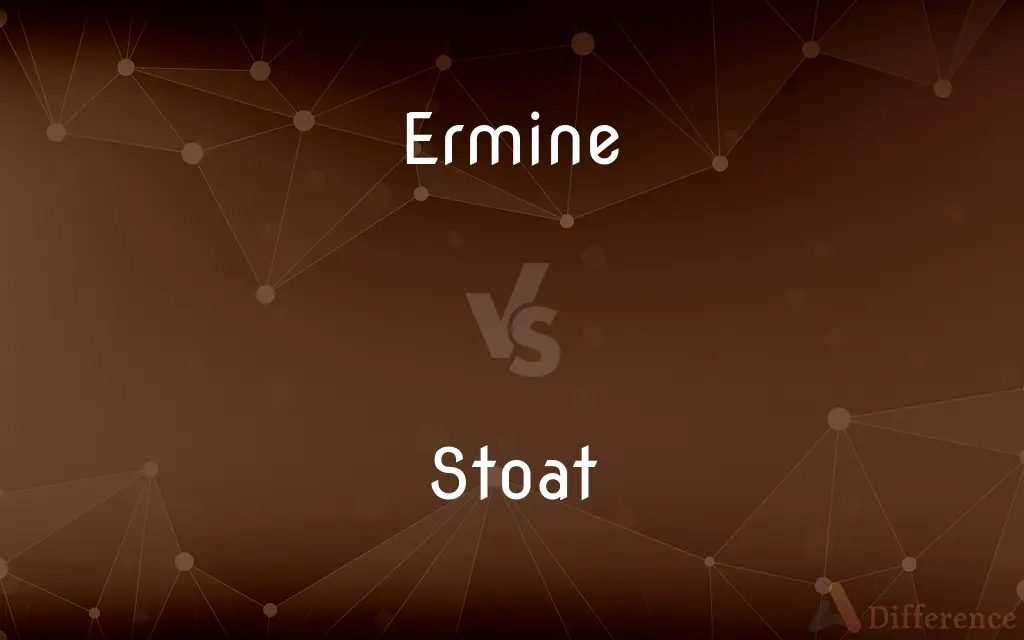Ermine vs. Stoat — What's the Difference?
Edited by Tayyaba Rehman — By Urooj Arif — Updated on March 28, 2024
Ermine and stoat refer to the same animal; "ermine" typically denotes the animal's white winter coat, while "stoat" refers to its appearance outside this season.

Difference Between Ermine and Stoat
Table of Contents
ADVERTISEMENT
Key Differences
The terms "ermine" and "stoat" describe the same species, Mustela erminea, known for its ability to change fur color with the seasons. In warmer months, the stoat sports a brown upper coat and a lighter underbelly, which is why it's generally known as a stoat during this time. In contrast, during winter, its coat turns white, except for the tip of its tail which remains black, leading to its identification as an ermine. This color change is a camouflage adaptation to snowy environments.
While the term "stoat" is used year-round in some regions to refer to the animal regardless of its coat color, "ermine" is often reserved for describing the animal or its fur in the winter phase. The use of "ermine" is also prevalent in historical and ceremonial contexts, particularly in Europe, where ermine fur has been associated with royalty and nobility, symbolizing purity and high status.
The stoat is a versatile predator, adapting to a range of habitats including woodlands, marshes, and even urban areas. Despite its small size, it is a formidable hunter, preying on rodents, birds, and occasionally larger animals. The distinction between the ermine and stoat phases highlights the animal's ecological adaptability and the human cultural significance attributed to its winter coat.
Both terms showcase the unique biological feature of seasonal coat color change in Mustela erminea, but the context in which each term is used can vary based on geographical location, time of year, and historical or cultural relevance. This adaptability not only speaks to the stoat's survival strategy but also to its role in human symbolism and tradition.
Comparison Chart
Seasonal Appearance
White winter coat
Brown summer coat
ADVERTISEMENT
Cultural Significance
Associated with royalty and purity
Generally lacks the same level of historical or ceremonial significance
Habitat
Adapt to snowy environments for camouflage
Found in various habitats, including woodlands and marshes
Hunting Behavior
Remains an efficient predator, using its white coat for camouflage
Versatile hunter, preying on rodents and birds among other things
Geographical Usage
"Ermine" is often used in Europe and for ceremonial contexts
"Stoat" is used more broadly, regardless of season
Compare with Definitions
Ermine
A stoat in its white winter phase.
The ermine blended seamlessly into the snowy landscape.
Stoat
Found in a variety of habitats across the Northern Hemisphere.
Stoats are adaptable creatures, thriving in both woodlands and fields.
Ermine
The fur of the stoat used in clothing or as a trim.
Her vintage jacket was adorned with ermine fur along the collar.
Stoat
Known for its distinctive black-tipped tail.
Even in winter, the stoat's tail remains black at the tip, distinguishing it from other white-furred animals.
Ermine
A representation of this animal in heraldry and fine art.
The family crest featured an ermine, a symbol of their ancestral lineage.
Stoat
A small carnivorous mammal known for its seasonal fur color change.
The stoat is a proficient hunter, capable of taking down prey much larger than itself.
Ermine
The white winter coat of the stoat, especially when used as a symbol of purity or in ceremonial robes.
The king's cloak was trimmed with ermine, signifying his royal status.
Stoat
The name used to describe the animal outside its winter phase.
In summer, the stoat's fur turns a light brown, contrasting with its white belly.
Ermine
Used historically to denote high social status or nobility.
Ermine fur was a common element in the portraits of European nobility.
Stoat
Valued for its fur in the fashion industry, albeit controversially.
Stoat fur, especially in its winter phase, has been prized for centuries in the making of luxurious garments.
Ermine
A weasel (Mustela erminea) native to northern regions, having a black-tipped tail and dark brown fur that in winter changes to white. Also called stoat.
Stoat
The stoat or short-tailed weasel (Mustela erminea), also known as the Eurasian ermine, Beringian ermine, or simply just ermine, is a mustelid native to Eurasia and the northern portions of North America. Because of its wide circumpolar distribution, it is listed as Least Concern on the IUCN Red List.The name ermine is used for species in the genus Mustela, especially the stoat, in its pure white winter coat, or the fur thereof.Introduced in the late 19th century into New Zealand to control rabbits, the stoat has had a devastating effect on native bird populations.
Ermine
The commercially valuable white fur of this animal.
Stoat
See ermine.
Ermine
A weasel found in northern latitudes (Mustela erminea in Eurasia, Alaska, and the Arctic, Mustela haidarum in Haida Gwaii, Mustela richardsonii in the rest of North America); its dark brown fur turns white in winter, apart from the black tip of the tail.
Stoat
The fur of this animal, especially in its brown summer phase.
Ermine
The white fur of this animal, traditionally seen as a symbol of purity and used for judges' robes.
Stoat
, the ermine or short-tailed weasel, a mustelid native to Eurasia and North America, distinguished from the least weasel by its larger size and longer tail with a prominent black tip.
Ermine
The office of a judge.
Stoat
The ermine in its summer pelage, when it is reddish brown, but with a black tip to the tail. The name is sometimes applied also to other brown weasels.
Ermine
(tincture) A white field with black spots.
Stoat
The ermine in its brown summer coat with black-tipped tail
Ermine
Any of various moths, especially in the family Yponomeutidae
Ermine
(tincture) In blazon, of the colour ermine (white with black spots).
Ermine
To clothe with ermine.
Ermine
A valuable fur-bearing animal of the genus Mustela (M. erminea), allied to the weasel; the stoat. It is found in the northern parts of Asia, Europe, and America. In summer it is brown, but in winter it becomes white, except the tip of the tail, which is always black.
Ermine
The fur of the ermine, as prepared for ornamenting garments of royalty, etc., by having the tips of the tails, which are black, arranged at regular intervals throughout the white.
Ermine
By metonymy, the office or functions of a judge, whose state robe, lined with ermine, is emblematical of purity and honor without stain.
Ermine
One of the furs. See Fur (Her.)
Ermine
To clothe with, or as with, ermine.
The snows that have ermined it in the winter.
Ermine
The expensive white fur of the ermine
Ermine
Mustelid of northern hemisphere in its white winter coat
Common Curiosities
Where can you find stoats?
Stoats can be found across the Northern Hemisphere, adapting to a wide range of habitats from forests to grasslands.
Is there a difference in behavior between an ermine and a stoat?
No, the behavior remains consistent; the difference lies in the seasonal fur color for camouflage and temperature regulation.
Are ermines endangered?
As of the last assessment, stoats (ermine) are not considered endangered globally, but local populations may face threats from habitat loss and other pressures.
Why does the stoat change color?
The stoat changes color to camouflage with its environment, white in snow-covered landscapes and brown in warmer, snowless conditions.
How can you tell a stoat from other similar animals?
A stoat can be identified by its size, behavior, and notably the black tip on its tail, which remains throughout its color changes.
How does the stoat's fur change color?
The color change is triggered by daylight length and temperature, with the fur growing in white during shorter, colder days and reverting to brown as days lengthen and temperatures rise.
Can stoats be kept as pets?
While stoats can be captivating, their wild nature and predation habits make them unsuitable and challenging to keep as pets.
What do stoats eat?
Stoats are carnivorous, feeding on rodents, birds, and occasionally larger prey relative to their size.
What role does the stoat play in ecosystems?
As predators, stoats help control populations of rodents and other small animals, playing a crucial role in maintaining ecological balance.
How are ermines depicted in art and heraldry?
Ermines are often depicted as symbols of purity, nobility, and status in heraldry and art, reflecting their historical association with European aristocracy.
Share Your Discovery

Previous Comparison
Tower vs. Spire
Next Comparison
Logogram vs. PictogramAuthor Spotlight
Written by
Urooj ArifUrooj is a skilled content writer at Ask Difference, known for her exceptional ability to simplify complex topics into engaging and informative content. With a passion for research and a flair for clear, concise writing, she consistently delivers articles that resonate with our diverse audience.
Edited by
Tayyaba RehmanTayyaba Rehman is a distinguished writer, currently serving as a primary contributor to askdifference.com. As a researcher in semantics and etymology, Tayyaba's passion for the complexity of languages and their distinctions has found a perfect home on the platform. Tayyaba delves into the intricacies of language, distinguishing between commonly confused words and phrases, thereby providing clarity for readers worldwide.
















































